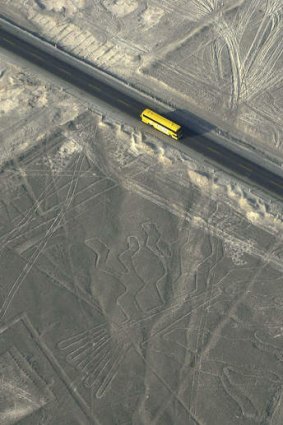
Lines in the land ... Peru's ancient curiosities are best viewed from the air.
Lance Richardson surveys the Nazca Desert's geoglyphs.
Driving south from Lima is like letting the eye drift into the blank margin of a page filled with newsprint. There is hastily assembled clutter, an information overload - then nothing. The city falls away, crumbling to sand. A roiling fog begins its optical trickery, and you start to wonder what would happen if you got lost out there.
The stark coastline south of Lima is one of the driest places on the planet. In fact, Peru is a geographic yin and yang: on one side is the Amazon, where everything is wet; on the other side is a coastal desert, where wetness is a distant mirage. These opposites are divided by the Andes mountain range.
As I drive into the desert on my way to a small airfield, it occurs to me that deserts have a monopoly on strange sites around the world. The Northern Territory has Uluru, for instance. Namibia has Deadvlei, a white salt pan with petrified camel thorn trees that look like Giacometti sculptures. Black Rock Desert in Nevada hosts the annual Burning Man festival, where thousands of Americans set fire to wooden effigies and dance in outlandish costumes or their underpants. Nothing nurtures the surreal like extreme climates.
In 1927, a Peruvian archaeologist named Toribio Mejia Xesspe went wandering in the Nazca Desert of southern Peru. He stumbled on a site so strange, it has fascinated visitors since it came to prominence in the 1940s. Seen from ground level, the Nazca Lines are a series of shallow trenches scratched into the gravel of the Pampa Colorada (Red Plain). Seen from the air, they resolve into fantastical shapes of extraordinary geometrical precision. Scientists and writers have argued for decades over how they were made by the Nazca people, who faded into history about 600AD. More outlandish theories involve hot-air balloons or, in the debunked hypothesis of author Erich von Daniken, ancient astronauts from outer space: the lines and figures could have been "built according to instruction from aircraft", he claims.
My aircraft is an Aerodiana light plane. Instruction: do not eat before you attempt to view the Nazca Lines. After reaching the desert airfield, I clear a security checkpoint and sit behind the cockpit. We take off over a vast plain that resembles lumpy, dimpled custard and my imagination goes into autopilot: is that an old Inca road or power lines? Is that dark patch man-made, or the shadow of clouds? Is this rising sickness, or a psychological trick? It continues this way for nearly 40 minutes as we fly over ridges and crenulated plains. And then suddenly, the pilot points out the window at an enormous spider. The Nazca Lines could more accurately be described as the Nazca Menagerie.
Over 50 kilometres of land is a condor, humming bird, whale, parrot, monkey, and a heron 300 metres long. There are also pyramids, hands and a human figure, "the astronaut".
Circling above this giant sketchpad, it's understandable that writers such as von Daniken jumped to intergalactic conclusions. How extraordinary that we rely on a modern invention, planes, to see something so ancient. American scientists recently recreated the lines, proving they were possible without alien help. The real mystery is not how the Nazca made them, but why.
Whether constellation maps or an appeal to the gods for water, be assured: doodling in the margins takes on a whole new meaning in Peru.
FAST FACTS
Getting there LAN has a fare to Lima from Sydney for about $2110 low-season return including tax. Fly to Santiago (about 16hr including transit time in Auckland), then non-stop to Lima (3hr 55min). 1800 558 129, lan.com. Melbourne passengers pay about $2200 and fly to and from Auckland to connect.
Staying there A convenient base for viewing the Nazca Lines is Paracas. Libertador Paracas offers comfortable suites right on the ocean starting from $US260 ($246) a night. Libertador Paracas offers aerial viewings of the Nazca Lines five times a day, including transport to and from Pisco Airport. The cost is $US250 a person. See libertador.com.pe/en.
Flying there Viewings of the Nazca Lines can be booked from Pisco Airport directly with Alas Peruanas. The cost is $US130 a person. See alasperuanas.com.
More information See peru.travel.
Lance Richardson travelled courtesy of PromPeru, LAN Airlines, and Condor Travel.
Sign up for the Traveller Deals newsletter
Get exclusive travel deals delivered straight to your inbox. Sign up now.